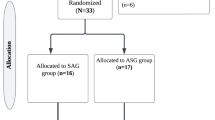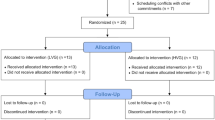Abstract
Background
This study aimed to investigate the effects of different intra-session exercise orders during concurrent training (CT) on endurance performance in elderly men, as well as to verify its influence on individual responses in endurance performance.
Design
Twenty-five healthy elderly men (64.7 ± 4.1 years) were placed into two groups: strength training prior to endurance training (SE, n=13), and one in the reverse order (ES, n=12). CT was performed three times a week during 12 weeks. Before and after training, peak oxygen uptake (VO2peak), maximal workload (Wmax), absolute and relative cycling economy at 25, 50, 75 and 100 W (i.e., average VO2 at different stages) were assessed.
Results
Similar increases in VO2peak were observed in the SE and ES groups (SE: 8.1 ± 9.9%; ES: 9.3 ± 9.8%; P<0.001), as well as in Wmax (SE: 19.9 ± 19.3%; ES: 24.1 ± 24.0%; P<0.001). Moreover, significant reductions were observed in the absolute VO2 at 100 W (P<0.05) in the SE and ES groups. No difference between groups was observed. In the ES group, one subject did not respond positively in terms of both VO2max and Wmax, whereas 4 subjects did not respond positively in terms of both VO2max and Wmax in SE group.
Conclusions
CT improved maximal and submaximal endurance performance in elderly men, independent of intra-session exercise order. However, it seems that the ES order elicited more individual responsiveness in terms of maximal endurance performance than SE order..








Similar content being viewed by others
References
Fleg JL, Lakatta G. Role of muscle loss in the age-associated reduction in VO2max. J Appl Physiol 2009;65:1147–1151.
Izquierdo M, Hakkinen K, Antón A, Garrues M, Ibañez J, Ruesta, M, Gorostiaga EM. Maximal strength power, endurance performance, and serum hormones in middleaged and elderly men. Med Sci Sports Exer 2001;33:1577–1587.
Izquierdo M, Hakkinen K, Ibanez J, Anton A, Garrues M, Ruesta M, Gorostiaga EM. Effects of strength training on submaximal and maximal endurance performance capacity in middle-aged and older men. J Strength Cond Res 2003;17:129–139.
Aagaard P, Suetta C, Caserotti P, Magnusson SP, Kjaer M. Role of the nervous sys-tem in sarcopenia and muscle atrophy with aging: strength training as a countermeasure. Scand J Med Sci Sports 2010;20:49–64.
Blair SN, Kampert JB, Kohl 3rd HW, Barlow CE, Macera CA, Paffenbarger RS Jr, Gibbons LW. Influences of cardiorespiratory fitness and other precursors on cardiovascular disease and all-cause mortality in men and women. JAMA 1996;276:205–210.
Farrell SW, Finley CE, Haskell WL, Grundy SM. Is there a gradient of mortality risk among men with low cardiorespiratory fitness? Med Sci Sports Exerc 2014;47:1825–1832.
Cadore, EL, Pinto RS, Alberton CL, Pinto SS, Lhullier LFR, Tartaruga MP, Correa CS, Al-meida APV, Silva EM, Laitano O, Kruel LFM. Neuromuscular economy, strength and endurance in healthy elderly men. J. Strength Cond. Res 2011;25:997–1003.
Karavirta L, Häkkinen A, Sillanpää E, Garcia-Lopez D, Kauhanen A, Haapasaari A, Alen, M, Pakarinen A, Kramer WJ, Izquierdo M, Gorostiaga EM, Häkkinen K. Effects of combined endurance and strength training on muscle strength, power and hypertrophy in 40-67-year-old men. Scand. J. Med. Sci. Sports 2011;21:401–411.
Izquierdo M, Ibañez J, Häkkinen K, Kraemer WJ, Larrión JL, Gorostiaga EM. Once weekly combined resistance and cardiovascular training in healthy older men. Med Sci Sports Exerc 2004;36:435–443.
Hartman MJ, Fields DA, Byrne NM, Hunter GR. Resistance training improves meta-bolic economy during functional tasks in older adults. J Strength Cond Res 2007;21:91–95.
Wood RH, Reyes R, Welsch MA, Favaloro-Sabatier J, Sabatier M, Matthew Lee C, Johnson LG, Hooper PF. Concurrent cardiovascular and resistance training in healthy older adults. Med Sci Sports Exerc 2001;33:1751-1758.
Sillampää E, Häkkinen A, Punnonen K, Häkkinen K, Laaksonen DE. Effects of strength and endurance training on metabolic risk factors in healthy 40-65-year-old men. Scand J Med Sci Sports 19:885–895.
Holviala J, Häkkinen A, Karavirta L, Nyman K, Izquierdo M, Gorostiaga EM, Avela J, Korhonen J, Knuutila VP, Kraemer WJ, Häkkinen K. Effects of combined strength and endurance training on treadmill load carrying walking performance in aging men. J Strength Cond Res 2010;21:1583–1595.
Cadore EL, Izquierdo M, Alberton, CL, Pinto RS, Conceição M, Cunha G, Radaelli R, Bottaro M, Trindade GT, Kruel LF. Strength prior to endurance intra-session exercise se-quence optimizes neuromuscular and cardiovascular gains in elderly men. Exp Gerontol 2012;47:164–169.
Schumann M, Yli-Peltola K, Abbis CR, Häkkinen K. Cardiorespiratory adaptations during concurrent aerobic and strength training in men and women. PLoS One 2015. Doi: 10.1371/journal.pone.0139279.
Bouchard C, Rankinen T. Individual differences in response to regular physical activity. Med Sci Sports Exerc 2001;33:446–451.
Skinner JS, Jaskólski A, Jaskólska A, Krasnoff J, Gagnon J, Leon AS, Rao DC, Wilmore JH, Bouchard C. Age, sex, race, initial fitness, and response to training: The HERIT-AGE Family Study. J Appl Physiol 2001;90:1770–1776.
Sisson SB, Katzmarzyk PT, Earnest CP, Bouchard C, Blair SN, Church TS. Volume of exercise and fitness nonresponse in sedentary, postmenopausal women. Med Sci Sports Exerc 2009;41:539–545.
Alvarez C, Ramírez-Campillo R, Ramírez-Vélez R, Izquierdo M. Effects and Prevalence of Non-Responders after 12 weeks of High-Intensity Interval or Resistance Training in Adult Woman with Insulin Resistance: A Randomized Trial. J Appl Physiol 2017;122:985–996.
Karavirta L, Häkkinen A, Sillanpää E, García-López D, Kauhanen A, Haapasaari A, Alen M, Pakarinen A, Kraemer WJ, Izquierdo M, Gorostiaga E, Häkkinen, K. Effects of combined endurance and strength training on muscle strength, power and hypertrophy in 40-67-year-old men. Scand J Med Sci Sports 2011;21:401–411.
Bonafiglia JT, Rotundo MP, Whittall JP, Scribbans TD, Graham RB, Gurd, BJ. Inter-Individual variability in the adaptive responses to endurance and Sprint interval training: A randomized crossover study. PLoS One 2016. Doi:10.1371/journal. pone.0167790.
Bouchard C, Blair SN, Church TS, Earnest CP, Hagberg JM, Häkkinen K, Jenkins NT, Karavirta L, Kraus WE, Leon AS, Rao DC, Sarzynski MA, Skinner JS, Slentz CA, Rankinen T. Adverse metabolic response to regular exercise: is it a rare of common occurrence? PLoS One, 2012.doi: 10.1371/journal.pone.0037887.
Gurd BJ, Giles MD, Bonafiglia JT, Raleigh JP, Boyd JC, Ma JK, Zelt JG, Scribbans TD. Incidence of nonresponse and individual patterns of response following Sprint inter-val training. Appl Physiol Nutr Metab 2016;41:229–234.
Scharhag-Rosenberger F, Walitzek S, Kindermann W, Meyer T. Differences in adaptations to 1 year of aerobic endurance training: Individual patterns of nonresponse. Scand J Med Sci Sports 2012;22:113–118.
Cadore EL, Pinto RS, Lhullier FLR, Correa CS, Alberton CL, Pinto SS, Almeida AP, Tarta-ruga MP, Silva EM, Kruel LF. Physiological effects of concurrent training in elderly men. Int J Sports Med 2010;31:689–697.
Jackson AS, Pollock ML. Generalized equations for predicting body density of men. Brit J Nutr 1978;40:497–504.
Siri WE. Body composition from fluid spaces and density: analysis of methods. Nu-trition 1993;9:480–491.
Hopkins WG. Measures of reliability in sports medicine and Science. Sports Med 2000;30:1–15.
Izquierdo-Gabarren M, Expósito RGT, García-Pallarés J, Sánchez-Medina L, De Villarreal ES, Izquierdo M. Concurrent endurance and strength training not to failure optimizes performance gains. Med Sci Sports Exerc 2010;41:1191–1199.
Hedgess LV, Olkin I. Statistical methods for meta-analysis. 1st ed. Academic Press: Orlando FL p. 369, 1985.
Hopkins WG, S.W. Marshall SW, Batterham AM, Hanin J. Progressive statistics for studies in sports medicine and exercise Science. Med Sci Sports Exerc 2009;41:3–13.
Cadore EL, Pinto RS, Lhullier FLR, Correa CS, Alberton CL, Pinto SS, Almeida APV, Tar-taruga MP, Silva EM, Kruel LFM. Effects of strength, endurance and concurrent training on aerobic power and dynamic neuromuscular economy in elderly men. J Strength Cond Res 2011;25:758–766.
Baar K. Training for endurance and strength: Lessons from cell signaling. Med Sci Sports Exerc 2006;38:1939–1944.
Conceição M, Cadore EL, González-Izal M, Izquierdo M, Liedtke GV, Wilhelm EN, Pinto RS, Goltz FR, Schneider CD, Ferrari R, Bottaro M, Kruel LFM. Strength training prior to endurance exercise: Impact on the neuromuscular system, endurance performance and cardiorespiratory responses. J Hum Kinet 2014;44:171–181.
Ross R, de Lannoy L, Stotz PJ. Separate effects of Intensity and amount of exercise on interindividual cardiorespiratory fitness response. Mayo Clin Proc 2015;90:1–9.
Scribbans TD, Edgett BA, Vorobej K, Mitchell AS, Joanisse SD, Matusiak JB, Parise G, Quadrilatero J, Gurd BJ. Fibre-specific responses to endurance and low volume high intensity interval training: striking similarities in acute and chronic adaptation. PLoS One, 2014. Doi: 10.1371/journal.pone.0098119.
Montero D, Cathomen A, Jacobs RA, Flück D, de Leur J, Keiser S, Bonne T, Kirk N, Lundby AK, Lundby C. Haematological rather than skeletal muscle adaptations con-tribute to the increase in peak oxygen uptake induced by moderate endurance training. J Physiol 2015;593:4677–4688.
Astorino TA, Schubert MM. Individual responses to completion of short-term and chronic interval training: A retrospective study. PLoS One, 2014. Soi: 10.1371/ journal.pone.0097638.
Churchward-Venne TA, Tieland M, Verdijk LB, Leenders M, Dirks ML, de Groot LC, van Loon LJ. There are no nonresponders to resistance-type exercise training in older men and women. J Am Med Dir Assoc 2015;16:400–411.
Montero D, Lundby C. Refuting the myth of non-response to exercise training: ‘non-responders’ do respond to higher dose of training. J Physiol 2017 doi: 10.1113/ JP273480.
Author information
Authors and Affiliations
Corresponding author
Rights and permissions
About this article
Cite this article
Cadore, E.L., Pinto, R.S., Teodoro, J.L. et al. Cardiorespiratory Adaptations in Elderly Men Following Different Concurrent Training Regimes. J Nutr Health Aging 22, 483–490 (2018). https://doi.org/10.1007/s12603-017-0958-4
Received:
Accepted:
Published:
Issue Date:
DOI: https://doi.org/10.1007/s12603-017-0958-4




